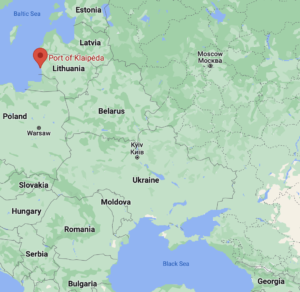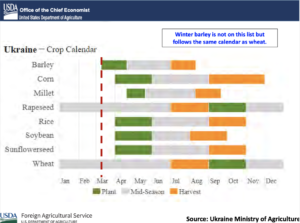As 2026 ushers in a fresh start, agricultural economists say the U.S. farm economy has stopped sliding, but it’s far from fully healed.The December Ag Economists’ Monthly Monitor shows month-to-month…
The “Race to Free Ukraine’s Stranded Grain” Persists, as Wheat Harvest Looms
Andrew Higgins and Erika Solomon reported in yesterday’s New York Times that, “The Baltic Sea port has silos to store plenty of grain, railway lines to transport it there from Ukraine, where it has been trapped by the war, and a deep harbor ready for ships that can take it to Egypt, Yemen and other countries in desperate need of food.
“‘Starvation is near, and we have everything that is needed to provide part of a solution,’ said Algis Latakas, the director general of Klaipeda Port on Lithuania’s Baltic coast, insisting that his facility can help the world avert a food catastrophe by getting out the vast mountains of grain now stranded in Ukraine.
“But, Mr. Latakas conceded, there is one big problem: Aleksandr G. Lukashenko, the president of Belarus — who in February let Russian troops pour into Ukraine from his territory. Belarus controls the railway lines offering the most direct, cheapest and fastest route for large volumes of grain out of Ukraine to Klaipeda and other Baltic ports.”

Yesterday’s article explained that, “But using them would mean cutting a deal with a brutal leader closely allied with President Vladimir V. Putin of Russia, underscoring the painful moral and political decisions that now confront Western leaders as they scramble to avert a global food crisis.
Numerous options are being considered to get the much-needed grain out of Ukraine, including sending barges down the Danube River, or by truck and train through ports in Poland and Romania — all of which come with considerable challenges. Hardest of all would be reopening the Black Sea port of Odesa, currently mined by Ukraine against invasion and blockaded by Russia.
Higgins and Solomon stated that, “The Lithuania route appears to be the most promising for getting food quickly to areas like the Middle East and Africa that need it the most, even if it is also a long shot.”
The Times article pointed out that, “Until Russia invaded on Feb. 24, Ukraine shipped most of its agricultural products through Odesa, and its main port on the Azov Sea in the now pulverized city of Mariupol.
“The war has halted those shipments, leaving around 25 million tons of grain, according to U.N. estimates, from last year’s harvest stranded in silos and at risk of rotting if it is not moved soon. A further 50 million tons is expected to be harvested in coming months. The grain elevators in Ukraine that have not been damaged or destroyed by shelling are quickly filling up. Soon, there will be no room left to store the incoming harvest.”

Reuters writer Natalia Zinets reported yesterday that, “Ukraine is working with international partners to create a United Nations-backed mission to restore Black Sea shipping routes and export Ukrainian farm produce, foreign ministry spokesman Oleg Nikolenko said on Thursday.”
Also yesterday, Wall Street Journal writer Natalia Ojewska reported that, “With only weeks left before Ukraine’s wheat harvest begins in earnest, Poland is racing to speed up the flow of grain from its war-torn neighbor, scouring Europe for spare train cars and containers, throwing new customs agents onto a truck-choked border and dispatching political leaders to far-off countries desperate to secure new shipments from Ukraine.
“The collective effort, described by Polish and Ukrainian officials and truck companies pitching in, is an attempt to help Ukraine export its wheat by land, circumventing Russia’s naval choke hold on Ukraine’s Black Sea shipping lanes. At best, Poland expects it could receive and reship one-third of the 4.5 million tons Ukraine would export monthly in peacetime, Poland’s Agriculture Minister Henryk Kowalczyk said Thursday. That would be twice the current volumes currently moving through Poland.
“But first an inordinate amount of infrastructure and economic incentives have to be patched together, swiftly, before the wheat harvest gains speed near June’s end.”

Meanwhile, Reuters News reported yesterday that, “Russia’s defence ministry said on Thursday that vessels carrying grain can leave Ukraine’s ports in the Black Sea via ‘humanitarian corridors’ and Russia is ready to guarantee their safety, Interfax news agency said.”
And New York Times writer Elian Peltier reported yesterday that,
With many of the world’s poorest countries facing alarming levels of hunger and starvation, the leader of the African Union is set to meet with President Vladimir V. Putin on Friday and urge him to lift Russia’s blockade on urgently needed cereals and fertilizer from Ukraine
Elsewhere, The Wall Street Journal editorial board opined in today’s paper that, “World leaders are raising alarms about Vladimir Putin’s food blockade in Ukraine that threatens global shortages and political unrest, but so far they’re doing too little about it. Credit U.S. Gen. Christopher Cavoli for addressing the problem more forthrightly than politicians have.
“‘The problem of exporting or not exporting grain from Ukraine right now is an important problem not just for Ukraine but for the world,’ Gen. Cavoli said last week during his confirmation hearing to become NATO Supreme Allied Commander. ‘The way we approach that would have to be a whole-of-government approach, which may or may not include a military component.”
The Journal opinion item added that, “The White House is understandably worried about escalation, but this isn’t akin to a no-fly-zone in which the U.S. would shoot down Russian planes if they fly over Ukraine. This would be an escort operation in international waters that would take no action against Russian vessels that allowed commercial ships to sail without interference.
“If Mr. Putin won’t give up his blockade, what’s the better alternative? The answer shouldn’t be famine and riots.”





